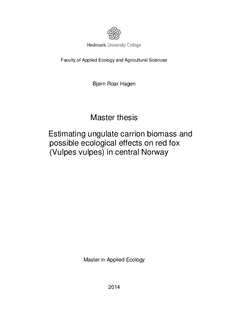| dc.description.abstract | Ungulates constitute the bulk of carrion in many terrestrial ecosystems. Knowledge of carrion availability is paramount to understand its ecological effects and I aimed to estimate carrion availability in Nord-Trøndelag county in central Norway. I also discuss possible ecological effects of carrion availability on a key stone predator in Scandinavia, the red fox (Vulpes vulpes).
I used literature to estimate average monthly carrion availability from wild ungulates (moose Alces alces and roe deer Capreolus capreolus) and livestock (domestic sheep Ovis aries and semi-domestic reindeer Rangifer tarandus tarandus). I estimated monthly carrion supply from four carrion sources; i) predation remains, ii) harvest remains, iii) traffic collisions and iv) other causes of death (OCD). Spatio-temporal carrion availability was divided in forest/agricultural areas and mountain areas during the cold and the warm season, respectively.
I found that domestic sheep contributed to maintain the annual stability of carrion supply in both areas by providing carrion only in the warm season. Estimated average annual carrion supply was by far most prominent in forest/agricultural areas (70 kg/km2). The supply peaked in the end of the warm season due to remains from the autumn harvest (25 kg/km2) from which discarded internal organs from moose constituted 20 kg/km2. Estimated carrion supply from harvest and OCD was of same magnitude and both resources are available over large areas. I suggest that harvest remains appear as more clumped distribution in lower altitudes near farmland due to moose and roe deer habitat preferences. I also suggest a similar distribution of OCD carcasses during the cold season due to migratory effects. Furthermore, winter severity most likely skews this availability towards late winter and spring.
Based on the findings, I expect increased red fox survival when the availability of voles is low. This is mainly due to the combined effect of estimated amounts of harvest remains in the face of winter and the amount of carrion supply during the cold season. Future research should focus on the importance of carrion availability on red fox distribution, density and reproduction. | nb_NO |
